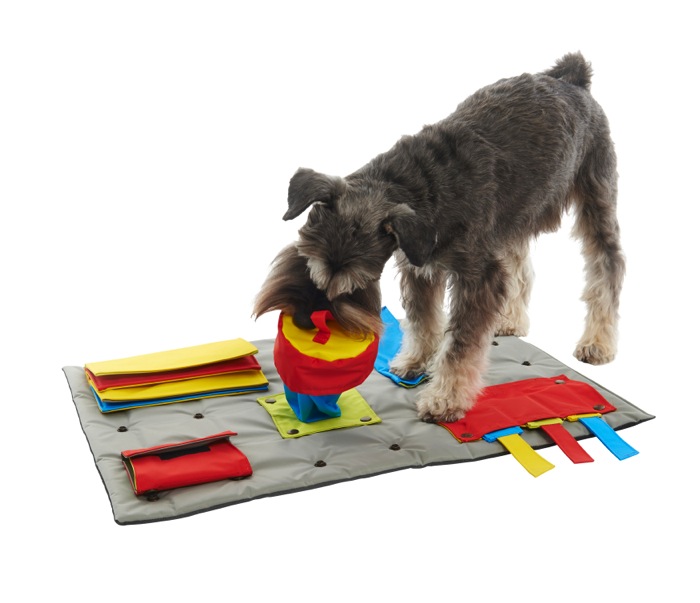When Karma-Kat showed up on our back patio, the 8-month-old kitten had been on his own for some time. Starved for attention, and for food, he ate anything and everything. Karma chewed through the dog food bag to munch kibble and practiced snatch-and-grab attacks to gobble food from our dinner plates.
Our last dog, Magic the German Shepherd, had a healthy appetite, but declined to gobble. But our newest pet, Bravo the Bullmastiff, occasionally scarfs-and-barfs in quick succession.
Pets are individuals of course, but I wondered why some pets practice gluttony while others are more discriminating. For answers, I reached out to Dottie Laflamme, DVM, PhD, a board-certified veterinary nutritionist.
Why Do Some Dogs Gobble Their Food?
“Gobbling of food seems to be a trait carried over from wolves,” says Dr. Laflamme. “Wolves or other canids in packs are in competition for access to a kill, so grab what they can when they can.”
In domestic dogs, she says speed of eating seems to be a breed-specific characteristic. Certain breeds of dogs swallow their food in a gulp or two, while others prefer to nibble or graze. “Beagles and Labrador Retrievers are among those breeds known to be gobblers,” she says.
In addition to breed, there is considerable individual variation in eating habits. “This may be related to early experiences and feeding management, and competition, real or perceived, for food bowl access, environmental factors, including those that may leave a dog more or less relaxed while eating, and availability of food.”
Breed doesn’t appear to play a role in feline gobblers. Dr. Laflamme says there are no scientific studies to identify the reasons behind “Garfield”-type cats. But she speculates there may be several reasons, alone or in combination, for this behavior in both cats and dogs.
Those starved as strays may be more food-focused, she says. Also, young pets who are meal-fed rather than free-fed during early development may be more likely to be rapid eaters. “This is based on a limited number of animals and personal observations,” she says, “but it also fits your Karma-Kat situation.”
Cats evolved as solitary hunters and eaters. It’s hard to share a single mouse, after all. That means when cats must share food bowls, eat side by side with other felines, or compete with another cat or dog, they may resort to gulping food quickly or risk getting nothing at all.
Does Gobbling Have Risks?
For cats, gorging can lead to obesity, or nutritional upset if they habitually vomit. Some veterinarians describe stressed-cat eating as “scarf-and-barf.” In other words, eating too quickly from stress-related causes can result in the cat’s food coming back up just as quickly. That’s not good for your carpet, your blood pressure, or your cats.
But for otherwise healthy dogs, gulping food isn’t necessarily a bad thing, says Dr. Laflamme. Eating quickly can save time for owners of multiple dogs, when you can control the amount each dog eats, she says. “Dogs can easily consume all their food in just a few minutes, so can be quickly fed once or twice daily. Since this is a natural pattern for dogs, it may not be of any concern.”
However, part of the natural pattern in wolves and pack animals is to gorge with rapid feeding, then regurgitate and re-consume the food while they are away from the frenzy. “Most pet owners are less keen on this habit, despite it being natural,” says Dr. Laflamme.
One health concern has been linked with rapid eating, says Dr. Laflamme. Gastric dilatation volvulus, or bloat, particularly affects large breed dogs, especially deep-chested dogs.
How to Slow Pet Food Consumption
Helping dogs and cats eat more slowly comes down to managing mealtime. Dr. Laflamme offers these suggestions:
- Add water to the food to increase volume
- Feed larger kibble or chunk sizes so pets must chew rather than gulp
- Use an automatic feeding device that opens on a scheduled timer to access a portion of the daily ration. That can divide a single meal into multiple small meals.
- Place one or more non-swallowable balls, large stones, or heavy chain into the feeding bowl so dogs must pick around obstacles to find kibbles.
- Use puzzle feeders designed for the purpose. Kibbles placed inside are released a few at a time during paw-rolling, nose-nudging play. Homemade versions can be made using plastic water bottles or similar.
- For cats gobbling out of competition or stress, consider feeding them separately.
- Hide puzzle toys for cats to “hunt.”
- Smear “licky mats” with canned food to slow consumption.
This article was reviewed/edited by board-certified veterinary behaviorist Dr. Kenneth Martin and/or veterinary technician specialist in behavior Debbie Martin, LVT.








